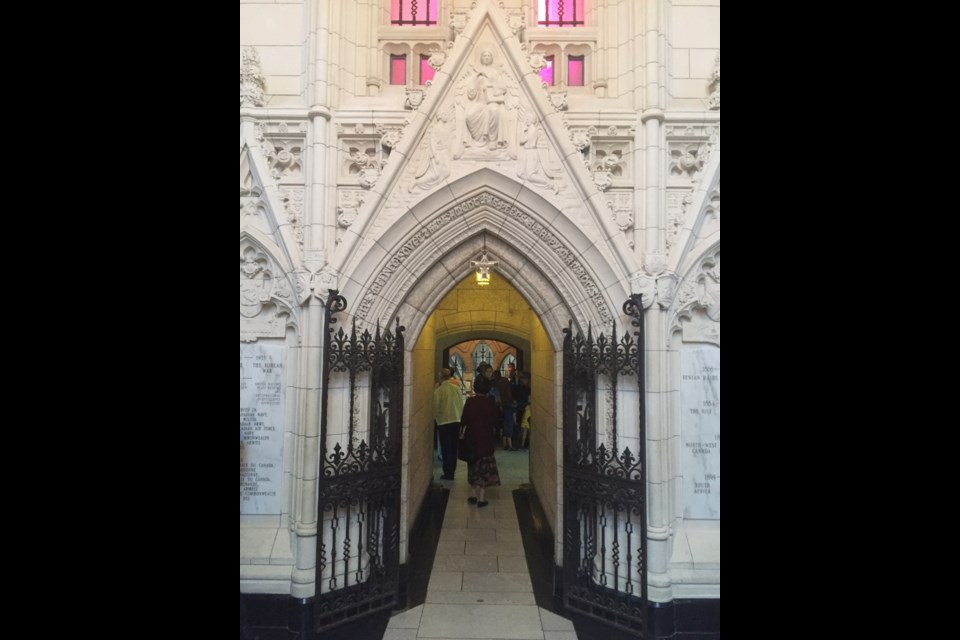It is a long way from the hamlet of Sultan, Ont., southeast of Chapleau, to the Memorial Chamber on the third floor of the Peace Tower in our Nation’s Capital.
What’s the connection?
The Peace Tower was designed by architect John A. Pearson; built not only to stand as a landmark, but also as a memorial. The inscription around this arch is an excerpt from John Ceredigion Jones' poem ‘The Returning Man’: “ALL'S WELL, FOR OVER THERE AMONG HIS PEERS A HAPPY WARRIOR SLEEPS.”
Who was the poet of these most famous lines? is he buried in the near wilderness?
The infamous inscription transcribed and found on many cenotaphs are the prose of Ceredigion-Jones (pronounced Kerr-red-dig-yon, with the accent on “dig”) and his life was a wayward one. John Ceredigion-Jones was a Welsh-Canadian poet who was a habitual writer of letters to the editor, and composer of poetry, most of it with a comic bent or tone.
As a penniless 64-year-old wayfarer in 1949, he was sent to Sultan by a Sudbury employment agency. There was work in Sultan, and he was given a job in the mill. He worked for a few days and dropped dead of an apparent heart attack. Nobody knew who he was because he had signed his work sheet as John C. Jones — a name that could be and probably was used by countless men who wished to conceal their identities.
Some of these findings are referenced within William McLeod’s book The Chapleau Game Preserve: History, Murder and Other Tales published in 2004 he was contacted. Bill said, in an interview with the manager of the local mill, “We did not know where he had come from beyond Sudbury. Ceredigion-Jones was buried in a rough wooden box with his boots on. Rev. Howard Strapp, who was the minister at the Chapleau United Church, conducted the ceremony.”
The unravelling of his past showed Jones had been born in Cardiganshire, Wales, March 1, 1883.
“He emigrated to Canada in 1904 and became a rolling stone. The Returning Man, was printed in the Calgary Albertan in 1919-20.”
That was around the same time that architect John A. Pearson was overseeing the building of the Peace Tower (1919-1927). As an inscription to be carved in stone over the entrance to the Memorial Chamber of the Peace Tower, Pearson chose the infamous lines.
“Pearson could not remember the source of these lines. At the time, the lines seemed so compelling that a search was undertaken to locate their author,” said McLeod. “The minions of British Prime Minister Stanley Baldwin and Canadian Prime Minister Mackenzie King and swarms of librarians could not locate the source. Then, in a letter-the editor of the Montreal Herald, a J.C. Jones of Montreal claimed that he had written the lines. To convince skeptical authorities, Jones produced a clipping from the Calgary Albertan. The Department of National Defence eventually accepted Jones’s claim and paid his $8. The year was 1939.”
Years went by and again it was not known who had penned the lines. Fast forward to the Canadian general election of 1953. Lester Pearson, Canada's Minister of External Affairs, was campaigning in his riding of Algoma East.
“He was trolling for votes in Sultan, and, after his speech, he was approached by the mill manager, John Pousette. He then escorted Pearson and J.E. Belliveau, a political correspondent, to the little cemetery. He told Pearson that the locals were wondering if there was some way the grave of John Ceredigion-Jones could be marked and preserved.
The stone is pyramid-shaped but there was nothing written on it. The chain and the pipes were intact. There is now a small rectangular, clear Plexiglas plaque hanging over the stone with an inscription identifying Ceredigion-Jones and his Peace Tower lines. Through a series of circumstances, McLeod said, “It was Floyd Laughren, the long-time MPP for Nickel Belt, who had arranged with the federal government to put that little plaque on Ceredigion-Jones grave.”
McLeod provided a final anecdote: “When I visited the grave late in the fall of 2002 it felt quite spooky and was glad to leave. It was late in the afternoon and very cloudy and cold. When I had the photos developed one clearly showed the outline of a ghost hovering over the rock at the head of the grave. Maybe it was just a photofinishing flaw. Never having seen one, I don’t know if I really believe in ghosts. But maybe the old poet was just happy to have a couple of visitors before the long Sultan winter set in. Or maybe he was telling us to get the hell out of there and leave him alone. I just don’t know.”
Our nation’s parliament buildings are easily found; Sultan, on the other hand, is northwest of Sudbury or southwest of Chapleau. There is a “T” intersection with Main St. headed into Sultan (from the Sultan Industrial Rd.) with Highway 667 towards Chapleau. Look carefully as the very small unmarked cemetery is nestled amongst the majestic jack pine and stately poplars and it is becoming overgrown. There is a large erratic marked with blue paint at the corner of all three roads.
The Jones’ grave, in the southwest corner, has a leaning chainlink supported by rusty pipes surrounding the plot along with an animal’s burrow; it is located at WGS 84 E 367878.00 N 5272293 or N 47° 35.435' W 82° 45.441'. It is 592 kilometres by road or 368 kilometres in a straight line, from the grave site to the Memorial Chamber of the Peace Tower.
